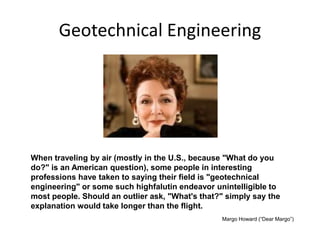Geotheta Fundamentals Explained
Geotheta Can Be Fun For Anyone
Table of ContentsThe Buzz on GeothetaWhat Does Geotheta Mean?Geotheta Things To Know Before You Get ThisGeotheta for DummiesWhat Does Geotheta Do?

They carry out site investigations, accumulate samples, perform lab examinations, and analyze information to evaluate the suitability of the ground for building projects - Consulting Engineer. Based on their searchings for, geotechnical designers provide referrals for foundation layout, slope stability, retaining frameworks, and mitigation of geotechnical risks. They team up with various other specialists, such as designers, architectural engineers, and building groups, to make sure that geotechnical considerations are integrated into the overall project style and implementation
By examining the habits and residential properties of dirt and rock, they can identify possible geotechnical dangers such as landslides, dirt negotiation, or incline instability. Their experience helps avoid failings or mishaps that might endanger lives and property. Right here are some comprehensive duties and responsibilities of a geotechnical engineer: Site Investigation: Geotechnical designers conduct website examinations to collect data on subsurface problems.
They translate the information to recognize the residential or commercial properties and behavior of the dirt and rock, including their strength, permeability, compaction qualities, and groundwater problems. Geotechnical Analysis and Layout: Geotechnical engineers analyze the information gathered during site investigations to analyze the security and suitability of the website for building jobs. They carry out geotechnical calculations and modeling to assess elements such as birthing capability, negotiation, incline stability, side earth stress, and groundwater circulation.
Geotheta Can Be Fun For Anyone
Structure Style: Geotechnical engineers play a critical function in making foundations that can securely support the intended framework. They evaluate the dirt conditions and tons requirements to determine the suitable foundation type, such as shallow structures (e.g., grounds), deep structures (e.g (https://geotheta.edublogs.org/2024/08/02/unlocking-the-world-of-geotechnical-engineers-with-geotheta/)., stacks), or specialized techniques like soil renovation. They think about elements such as negotiation limitations, birthing ability, and soil-structure interaction to establish optimum structure styles
They assess building strategies, monitor site tasks, and carry out field assessments to verify that the style suggestions are adhered to. If unanticipated geotechnical issues emerge, they analyze the situation and supply recommendations for remediation or modifications to the layout. Danger Analysis and Mitigation: Geotechnical designers evaluate geotechnical hazards and threats linked with the job website, such as landslides, liquefaction, or soil disintegration.

Cooperation and Communication: Geotechnical designers work very closely with other specialists associated with a task, such as architects, architectural engineers, and building and construction groups. Reliable interaction and collaboration are vital to incorporate geotechnical factors to consider into the overall task design and building and construction procedure. Geotechnical designers supply technological knowledge, solution inquiries, and ensure that geotechnical needs are satisfied.
A Biased View of Geotheta
Right here are some kinds of geotechnical engineers: Foundation Engineer: Foundation designers focus on designing and assessing foundations for structures. They examine the dirt conditions, load demands, and site features to figure out the most proper structure type and style, such as superficial structures, deep structures, or specialized techniques like pile foundations.
They evaluate the factors influencing incline stability, such as soil residential or commercial properties, groundwater conditions, and slope geometry, and create strategies to avoid incline failings and minimize threats. Quake Designer: Quake engineers focus on evaluating and designing structures to stand up to seismic pressures. They analyze the seismic risk of a site, review dirt liquefaction potential, and establish seismic style requirements to make certain the safety and strength of structures throughout earthquakes.
They carry out area testing, collect samples, and analyze the collected information to identify the dirt residential properties, geologic developments, and groundwater conditions at a site. Geotechnical Instrumentation Designer: Geotechnical instrumentation engineers concentrate on tracking and measuring the actions of dirt, rock, and frameworks. They install and keep instrumentation systems that keep an eye on factors such as dirt negotiation, groundwater levels, incline motions, and structural displacements to assess efficiency and provide very early warnings of possible issues.
A Biased View of Geotheta
They carry out tests such as triaxial examinations, loan consolidation tests, straight shear examinations, and permeability tests to gather information for geotechnical analysis and style. Geosynthetics Engineer: Geosynthetics engineers focus on the layout and application of geosynthetic materials, such as geotextiles, geogrids, and geomembranes. They utilize these materials to boost soil security, strengthen slopes, offer water drainage options, and control disintegration.
They have a tendency to be investigatory individuals, which implies they're intellectual, introspective, and analytical. They are curious, systematic, rational, analytical, and rational. Some of them are additionally social, meaning they're kind, charitable, cooperative, client, caring, helpful, understanding, skillful, and pleasant - Geotechnical Engineers.
In the office atmosphere, geotechnical designers utilize specialized software tools to perform computations, produce designs, and evaluate information. They prepare records, review project specs, communicate with customers and staff member, and coordinate project activities. The office setting supplies a conducive atmosphere for research, evaluation, and partnership with other professionals associated with the job.
The Ultimate Guide To Geotheta
They often see task websites to perform site investigations, assess geotechnical conditions, and collect data for evaluation. These gos to include traveling to different locations, occasionally in remote or challenging terrains. Geotechnical designers might perform soil tasting, conduct tests, and display building activities to make certain that the geotechnical elements of the project are being applied appropriately.
Geotechnical designers also work in specialized geotechnical labs. Geotechnical More about the author lab engineers work extensively in these settings, handling testing devices, operating tools, and taping data.